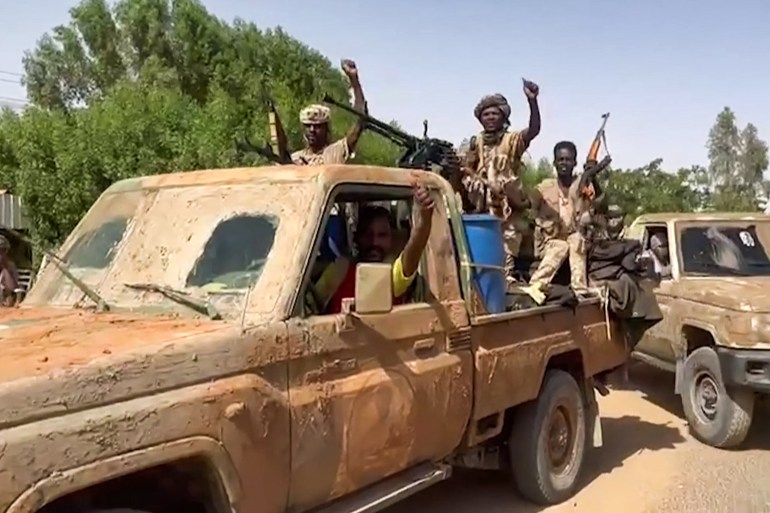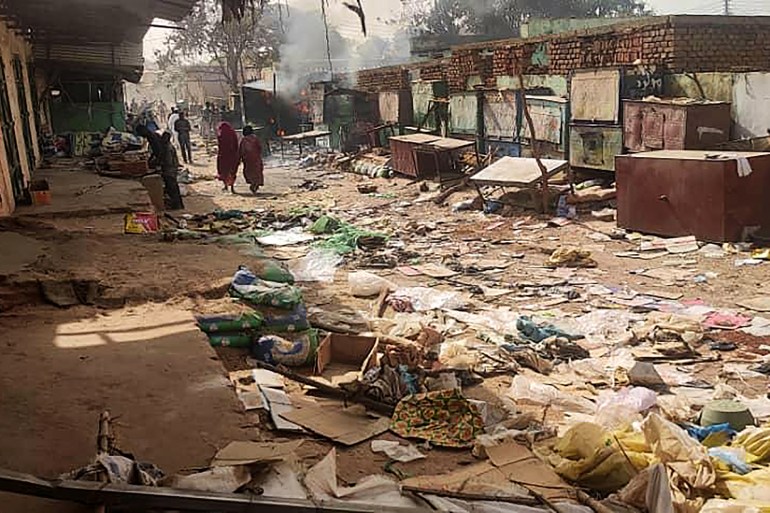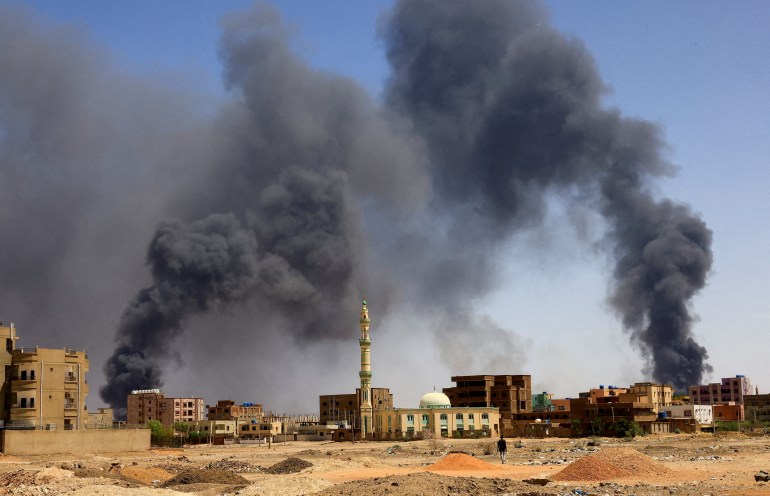The crisis in Sudan is in its fifth week with no end in sight.
Neither the Sudanese Armed Forces (SAF) nor the paramilitary Rapid Support Forces (RSF) have been able to gain decisive victories in the capital, Khartoum.
But their inability to overpower each other is not totally surprising. Instead, it is largely a byproduct of longtime President Omar al-Bashir’s strategy of rule in a country that has witnessed 16 failed and successful coup attempts since its independence.
Having come to power through a military coup himself in 1989, al-Bashir needed to keep his own army in check without rendering it too weak to maintain his hold on power. A sizable paramilitary is seen as reducing the risk of military coups because it shifts executive power away from a regular military to add a layer of protection against foreseeable mutinies.
For one state to have two sizable, quasi-independent armed forces is extremely risky and only works if these armed forces fulfil different functions to counterbalance each other.
The RSF pitted against the SAF
Numbers on the size of Sudan’s army and the RSF vary widely. The SAF is estimated to have about 200,000 active personnel compared with the RSF, where estimates range from 70,000-150,000.
With the constitutional task of upholding domestic order and contributing to the country’s development, the SAF is the coercive backbone of Sudan’s political system. Under al-Bashir, military spending accounted for up to 29 percent of Sudanese government expenditures.
Al-Bashir ruled Sudan for 30 years until the military removed him in April 2019 on the back of months-long popular protests. After months of wrangling, the new ruling generals agreed in August 2019 to share power with civilians representing the protest movement during a transitional period before elections.
But in October 2021, Sudan’s fragile democratisation process came to an abrupt end when the leader of the army, Abdel Fattah al-Burhan, and the RSF commander, Mohamed Hamdan “Hemedti” Dagalo, seized total power in a coup. Cracks, however, soon emerged as the pro-democracy protests continued and the thorny issue of the RSF’s integration into the regular army remained unsolved.

Cameron Hudson, an analyst at the Center for Strategic and International Studies, said that in terms of their equipment and training, “[the] SAF are a conventional African army in the sense that their order of battle is in the domain of heavy weaponry and armour. They have tanks, armoured personnel carriers, and they have an air force which gives them air superiority.”
According to the SIPRI Arms Transfers Database, in the last decade, Belarus, China, Russia, and Ukraine were the SAF’s most important suppliers of aircraft, missiles and armoured vehicles. A United Nations arms embargo imposed in 2004 in response to violence in the Sudanese region of Darfur had disrupted supply chains for the SAF’s weapons.
“They struggled to keep their equipment operating because they could not get spare parts. Sudan is also a punishing environment for sophisticated weaponry because of the sand and heat. Equipment and maintenance were a challenge [for the SAF]”, Hudson said.
The RSF, on the other hand, is a non-conscripted force that was formally set up as an extension and counterweight to the SAF a decade ago, evolving from the so-called Janjaweed militias under the auspices of al-Bashir to combat secessionism in Darfur.
In 2015, the RSF was officially incorporated into the state’s coercive apparatus under the command of Hemedti, subjugated only under al-Bashir and his National Intelligence and Security Service.
Like the Janjaweed, members of the RSF were recruited by Hemedti from Arab tribes in Darfur. This makes the RSF culturally, ethnically and religiously more cohesive than the conscripted corps of the SAF.
The RSF also has its own revenue streams; private companies owned by Hemedti and members of his family, including holdings in gold mining, livestock and infrastructure.
In contrast to the SAF, the Janjaweed’s chief purpose was targeted armed campaigns against non-Arabs in remote areas. The RSF retained the Janjaweed’s tactical setup as a mobile guerrilla and counterinsurgency force. Domestically, it has previously fought in Kordofan, the Blue Nile State and Khartoum in 2019; outside Sudan, RSF members have fought against the Houthi rebels in Yemen.
In terms of weapons, the RSF uses some government-supplied arms, though it is also known to confiscate weaponry and vehicles from other militia.
“They are much more lightweight, using light armoured jeeps like Thatchers or Toyota Hilux vehicles with 50-calibre machine guns on them,” Hudson said. “The RSF was allowed to diverge and to sustain itself because it played a role that the SAF did not want to play. The SAF has often mobilised militia around the country to do the dirty work and hand-to-hand combat that they did not want to do or could not do.”
Hemedti’s political ambitions
As long as the RSF specialised in armed campaigns outside Khartoum, it could grow without directly challenging the SAF’s traditional political hegemony.
But the alliance between al-Burhan and Hemedti during the 2019 and 2021 coups disrupted the fragile co-existence of the two forces. Ultimately, analysts say Hemedti’s political ambitions pulled the RSF towards the centre of political power, trespassing into the SAF’s political domain.
With al-Burhan unable to rebuild a political base that would anchor his regime, the RSF’s original role as mutiny insurance devolved into a serious coup risk. The differences in the SAF’s and RSF’s internal organisation, equipment, and specialisation kept both armed forces in check until major disagreements emerged in March over a planned security sector reform aimed at restructuring the military. The intended merger of the RSF into the regular army would have eliminated the paramilitary force as a substantive coup risk while absorbing its firepower and reach in the country’s periphery.
“Usually, there is the risk of power struggles after coups. But coup plotters would find ways to mitigate them before attempting a coup,” researcher Jonathan Powell, from the University of Central Florida, said.

“New incumbents appease potential rivals early on, allocate ministries differently, or assign individuals to political posts far away from the political capital where they cannot cause trouble,” Powell explained.
If fighting does break out from within the military establishment, it is usually short-lived and ends in a quick and clear winner. “It is bizarre that a regime would let an armed force like the RSF become a serious rival in the political capital,” Powell said.
As the sticky matter of the RSF’s integration heated up in the weeks before the fighting, Powell noted that “it could have been that al-Burhan felt more secure in his position than he was.
“I would not discount the possibility that Al-Burhan’s lack of action was to avoid the clashes [between SAF and RSF] that we are seeing right now,” he added.
Khartoum’s urban setting is a problem for both SAF and RSF
With the fighting now in its second month, analysts say the urban setting of Khartoum poses a problem for both the RSF and SAF due to their combat histories and specialisations.
“[The SAF is] not known for being highly mobile on the ground, or even being precise with respect to their air force”, Hudson said.
The RSF, on the other hand, never had the same training as the army in defending fixed positions, holding territory, or sustaining attacks.
“The military can use long-range artillery and fighter jets to defend their positions. Up close they have tanks and heavy armour,” Hudson added. “The RSF is not positioned to hold territory and defend positions because it is configured like a guerilla force that strikes and retreats quickly.”

Many RSF recruits are also unfamiliar with the operational environment in the capital.
“These are people from the peripheral regions of the country with very little knowledge of the streets and neighbourhoods in Khartoum. The SAF has an advantage there because the SAF knows Khartoum. At the same time, the SAF is not mobile; it cannot defend positions reasonably well and it is not going to be able to chase the RSF around the city,” said Hudson.
Still, neither force appears to be adjusting its combat tactics to its surroundings.
Hudson pointed out that “the RSF uses the same tactics we know from the Janjaweed: they are pillaging, marauding, and looting in neighbourhoods”. With no established supply lines in Khartoum and their headquarters destroyed, Hudson said RSF fighters “go into people’s homes to steal food, water, supplies, and occupy [them]”.
Early in the crisis, meanwhile, reports surfaced that the Russian Wagner Group was lending tactical support to the RSF. Marcel Plichta, a research fellow at the Centre for Global Law and Governance, said that “there are claims on the use of Wagner aircraft or Wagner-operated airfields to lift material to the RSF, in particular portable surface-to-air missiles. From a military perspective, this niche capability is highly valuable to the RSF because al-Burhan controls the regular military’s air force and the RSF lack strong anti-aircraft capabilities”.
But Plichta cautioned that Wagner is still not a decisive force in this battle.
“The number of contractors currently active in Sudan is small compared to the tens of thousands of RSF and SAF personnel. The founder of the Wagner Group, Yevgeny Prigozhin, benefits from portraying it as more influential than it is. It is important to not overestimate the strength and influence of this group, as much as it is important to not downplay the harm it brings to civilians,” he said.
An exit from the conflict needs a decisive tactical win
Because the SAF and RSF were designed to be complementary rather than competing forces within one state, the conflict setting in Khartoum puts both in a deadlock, observers say. At the same time, the rift between al-Burhan and Hemedti has weakened state power.
The unclear situation on the ground deters political actors from intervening, in another blow to the already faltering democratic process.
“The coup in 2021 made it very clear that powerful figures in the security services were not willing to allow democratisation without serious preservation of their powers and the spoils they are getting from the system,” Powell said.
Hudson forecast that as long as neither RSF nor SAF has the upper hand, a chance for negotiations will not be in sight.
“I fear that neither of these sides wants to end the fighting,” he said.
“They have agreed to every ceasefire, though they did not implement them. What might create a real opening for dialogue is if one side is about to win. If one side gains a tactical advantage – like if the RSF is driven out of Khartoum – that might create a real opportunity for them to talk”.
